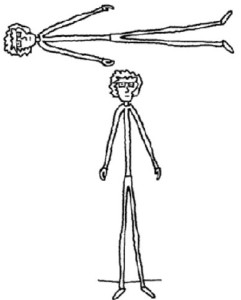IQ, EQ, SQ, and GQ

What’s a T-shaped person? At conferences on innovation there are often discussions about personality types that make for good innovators. One popular designation is “T-type” or “T-shaped” personalities. There are different definitions for T-types, so there is some confusion about what “T” means. For example, the “T” can stand for thrill seeking. “A personality type that takes risks. Type Ts tend to be extroverted and creative, and crave novel experiences and excitement; they can be positive (entrepreneurs) or negative (sociopaths); mental (Einstein, Galileo) or physical (extreme athletes).”
This definition has some predictive elements for would be innovators, but not enough.
Tim Brown of IDEO has an important definition for innovative types. “T-shaped people have two kinds of characteristics, hence the use of the letter “T” to describe them. The vertical stroke of the “T” is a depth of skill that allows them to contribute to the creative process. The horizontal stroke of the “T” is the disposition for collaboration across disciplines.” It is a combination of empathy and enthusiasm, which is “important because it allows people to imagine the problem from another perspective – to stand in somebody else’s shoes. Second, they tend to get very enthusiastic about other people’s disciplines, to the point that they may actually start to practice them. T-shaped people have both depth and breadth in their skills.”
Clearly these are both powerful attributes for an innovator to have. Let’s call the vertical line a skills quotient (SQ) and the horizontal line a empathy-enthusiasm quotient (EQ). EQ is a more specific aspect of the often cited emotional quotient. I would add that SQ should include an understanding of the fundamentals of value creation.
We can also add intelligence quotient (IQ) as another predictor of success. In individual creative acts, like aspects of music composition, mathematics, and writing, a high IQ is essential. And clearly a high IQ is usually desired for innovators as well. But innovation is a collaborative effort and genius often comes from putting together a team with strong, complimentary skills. Even Jobs and Gates had extremely talented partners in Wozniak and Allen. These teams had an abundance of IQ, SQ, and enough EQ.
But there is something else that is essential — grit. “Grit in psychology is a positive, non-cognitive trait based on an individual’s passion for a particular long-term goal or end-state, coupled with a powerful motivation to achieve their respective objective. This perseverance of effort promotes the overcoming of obstacles or challenges that lie within a gritty individual’s path to accomplishment, and serves as a driving force in achievement realization.” Jobs had industrial-strength grit.
Grit is often more important than IQ, SQ, and EQ. Without it nothing happens. Creating a major innovation usually takes years and there are endless challenges to be overcome. Grit is the one attribute that can make up for IQ, SQ, and to some extent EQ.
So perhaps the attributes required to be an innovator are not a T after all. They are the 4Qs: IQ, SQ, EQ, and GQ. As an equation: 4Q = IQ x SQ x EQ x GQ. They are multiplied because if any attribute is zero nothing good will happen.
I have worked with hundreds of teams developing significant innovations. The individuals and teams creating them were are all different, so the 4Q equation is useful primarily for stimulating discussion. The most surprising realization was that people with impressive IQs so often fail. As long as IQ reaches a threshold sufficient to master the required skills, the other factors determine success.
This is what is so insightful about Brown’s description. He is, in effect, assuming that if the skills can be mastered then IQ is sufficient and if the needed empathy and enthusiasm are there then, as a team, they will support each other to provide the needed grit.
Brown is CEO of IDEO, a superb, innovative-design company. Until 2014 I was CEO of SRI, an equally successful technology-innovation company. Like SRI, IDEO deeply understands that the way we work determines innovative success — or not. There are many differences between SRI’s and IDEO’s markets but there are many similarities in our innovation processes. One difference is that SRI regularly creates whole new market segments from major technology advances, like Siri. As described in a previous post, a major, disruptive innovation like Siri can take over a decade to develop. In order to bring such innovations to life requires uncommon levels of grit. We called people with the necessary skills and personal attributes Innovation Champions. At SRI one of our mottoes was, No champion, no project, no exception.”
3 Comments
PLR Articles
Very nice write-up. I certainly appreciate this site. Stick with it!
BTW, If you are looking to remodel your website with additional useful, interesting, search engine friendly content To Get Unlimited Visitors, & More Profit, than I request you to go to this site to Download FREE PLR Articles along with the most vauable Article Marketing Package. Kind regards
Jim Spohrer
Thanks – I tweeted this, and sent to some colleagues running the T Summit next week – http://tsummit.org
Curt
Thanks. Please let me know what happens.